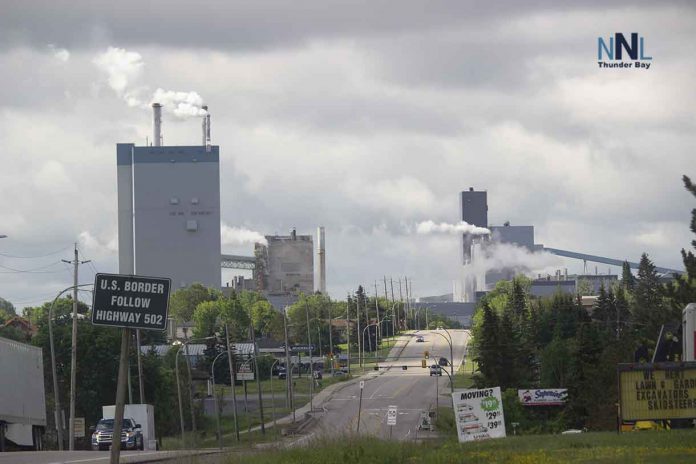Bankruptcy Can’t Stop Responsibility for Pollution Clean-up
OTTAWA – The Supreme Court of Canada has ruled on December 6, 2019, in a case from the Court of Appeal for Ontario that will have an impact on companies and across Northwestern Ontario. The 5-2 majority decision in R. v. Resolute FP Canada Inc. was brought over the mercury pollution that has impacted Grassy Narrows and the Islington First Nations.
The Supreme Court states in a brief on the case, “This case dealt with a company that was going bankrupt. Companies can still be responsible for following environmental rules even when they go bankrupt.”
For decades the impact of the dumping of mercury into the Wabigoon River in Dryden continued. As the mercury continued to be dumped the people downstream were impacted.
The mill changed hands many times over its history. In the past, the general premise that making money was more critical than protecting the health, and the environment held sway. As the company changed hands many times since the 1960s, the problem of past pollution became a focal point of keeping the mill open.
Supreme Court Case Synopsis
In the 1960s, there was a pulp and paper mill in Dryden, Ontario. A plant on the site produced chemicals to bleach the paper. The process involved using mercury. At the end of the process, the waste was dumped into nearby rivers. The mercury flowed downstream, where it poisoned people. Residents of the Grassy Narrows and Islington First Nations suffered serious, long-term health effects. In 1977, two First Nations bands sued for damage from mercury contamination.
By the late 1970s, the mill and plant were owned by a company called Reed. Another company, Great Lakes Forest Products, was interested in buying the properties. But it wasn’t sure about buying because of the lawsuit. A site had been built to safely bury the waste. Samples were taken and tested regularly to make sure there were no leaks. But Great Lakes didn’t want to be held responsible for past pollution.
The provincial government was afraid the local economy would suffer if the pulp and paper mill closed, so it wanted the sale to go through. It said it would give Great Lakes an “indemnity.” An indemnity is a kind of financial protection. In this case, the government agreed to cover costs above $15 million to settle legal claims for past pollution. In exchange, Great Lakes agreed to spend about $200 million to expand and upgrade the mill. The sale, with the indemnity agreement, went through in 1979.
The First Nations’ lawsuit ended in 1985. As part of the settlement, the government gave Great Lakes and Reed a new indemnity. It covered all claims due to previous pollution damage, including the mercury. It replaced the one from 1979 (and another from 1982). It applied to anyone who might take over the mill later.
In 2009, Bowater owned the waste disposal site, which was now separate from the mill. It filed for bankruptcy. As part of this process, a court allowed it to abandon the site in 2011. But the Ontario Ministry of the Environment said Bowater and Weyerhaeuser (the previous owner) still had responsibilities. It ordered them to repair the waste disposal site, keep monitoring and testing, and take steps to prevent and deal with leaks.
Weyerhaeuser said the indemnity from the 1985 settlement applied to the order. It said the provincial government had to pay for all the costs of complying. Bowater, which had become Resolute Forest Products, said the same thing.
The motion judge said the indemnity applied to the order. That meant the government had to cover the cost. The majority at the Court of Appeal said it applied but Resolute couldn’t claim it. It said the lower court should decide whether Weyerhaeuser could.
The majority of judges at the Supreme Court said the indemnity didn’t apply to the order. That meant Resolute and Weyerhaeuser had to cover the costs of complying with it.
The majority noted that the 1985 agreement didn’t say the government would cover the company’s costs of following environmental rules. It also wasn’t meant to cover claims between the government and the company. It was only supposed to cover claims by third parties (that is, people who didn’t sign the agreement).
The majority noted that the indemnity referred to “pollution claims.” But this wasn’t a pollution claim. There were no leaks and so no new pollution had happened. The order was about monitoring and testing to prevent more pollution. The majority said the indemnity was meant to cover claims for new pollution or for mercury already present in the environment from before. It didn’t mean claims for the mercury safely contained in the waste disposal site. The motion judge said mercury was leaking from the site, but this was a mistake.
The motion judge also said that the government gave the indemnity in 1985 as part of an exchange. In return, Great Lakes would invest in the Dryden plant. But this was a mistake. Great Lakes had already agreed to make this investment in 1979. It didn’t make any new commitments for the 1985 indemnity. The motion judge made his decision on the wrong facts, so the majority at the Supreme Court was allowed to change it.
Amanda Perreault with David Suzuki on Grassy Narrows
This is a developing story… Stay tuned.







